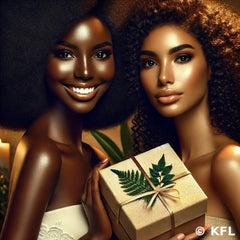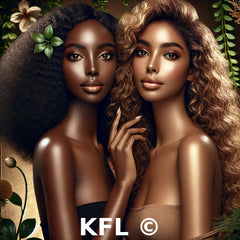
Understanding Your Hair Texture: How to Identify and Care for Curly, Coily, and Wavy Hair
Share Label
Understanding Your Hair Texture: How to Identify and Care for Curly, Coily, and Wavy Hair
Understanding your hair texture is essential for choosing the right care routine and maintaining healthy, beautiful hair. Curly, coily, and wavy hair each have unique characteristics, and knowing your hair type helps in selecting the best products and techniques. Here’s how to identify your hair texture!
1. The Different Types of Textured Hair
Hair is classified into several categories based on its natural structure:
- Type 2: Wavy Hair (2A, 2B, 2C) → Loose to well-defined waves.
- Type 3: Curly Hair (3A, 3B, 3C) → Well-defined curls that range from loose spirals to tighter ringlets.
- Type 4: Coily/Kinky Hair (4A, 4B, 4C) → Very tight curls or a zigzag pattern, often known for significant shrinkage.
2. How to Determine Your Hair Texture?
A. Observe Your Natural Curl Pattern
Let your hair air dry without applying any styling products:
- Loose Waves (Type 2): Hair forms natural waves but does not have distinct curls.

- Defined Curls (Type 3): Hair forms visible, well-shaped spirals.

- Tight Curls or Coily Hair (Type 4): Hair has very tight curls, spring-like coils, or a zigzag shape.

B. Analyze Your Hair Density
Run your fingers through your scalp:
- Fine Hair: You can easily feel your scalp.
- Normal Density: The scalp is slightly perceptible.
- Thick Hair: You feel mostly your hair mass rather than the scalp.
C. Test Hair Elasticity and Porosity
Take a clean, untreated strand of hair:
- If it stretches before returning to its original shape, your hair has good elasticity.
- If it breaks quickly, it is fragile and needs more moisture and protein treatments.
- If it absorbs water very quickly, your hair is high porosity and requires sealing with oils or butters to retain moisture.
3. Why Is It Important to Know Your Hair Texture?
Knowing your hair type helps you:
- Choose the right products: Coily 4C hair requires intense hydration, whereas wavy 3A hair may need lighter treatments.
- Adopt the best routine: Depending on hair density and porosity, the frequency of care may vary.
- Use the right tools: Wide-tooth combs, detangling brushes, or finger detangling may be more suitable depending on hair fragility.
Conclusion
Identifying your hair texture is the first step towards an effective hair care routine. Take time to observe your curls, analyze their reaction to moisture, and experiment with different products to understand what your hair truly needs.
Your hair is unique—care for it with love and patience! 💛









